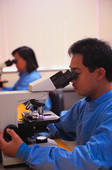
THURSDAY, May 20 (HealthDay News) — A large-scale effort to map out the genetic composition of hundreds of microorganisms that inhabit every human has produced its first results: scientists report they have completed the genome sequencing for an initial batch of 178 human-hosted bacteria.
Found in such places as the gastrointestinal tract, skin, mouth, uro-genital tract and respiratory tract, microbes such as the ones now sequenced are believed to play a central but as yet poorly understood role in daily human function, particularly with respect to the maintenance of health and onset of disease.
“This is just the beginning,” said study author Karen E. Nelson, director of the J. Craig Venter Institute in Rockville, Md. “There’s a lot of micro-diversity exclusive to our body, and we do not yet have comprehensive understanding of how these microbes interact with our bodies. So this is just the start of this exploration.”
“But I’m very encouraged,” Nelson added. “Because over the past five to 10 years, we’ve begun to realize how significant the microbes are that live on and in us. They’re clearly associated with health and disease. And some of the major diseases are associated with good bugs that go bad. Cavities, cancers, gastric tract disease, skin diseases, acne — a lot of everyday conditions that we deal with if we can get a better understanding of how it all works.”
The study, funded in part by the U.S. National Institutes of Health, was published in the May 21 issue of Science.
The current gene-mapping milestone joins other recent cutting-edge efforts, including the work of Chinese scientists who in the March issue of Nature announced the successful sequencing of 3.3 million genes from organisms living in the human gut. Taken together, such steps aim to unravel the intricate connections between humans and their bacterial tenants.
Nelson and her team began their research in 2007 in collaboration with three other U.S. educational institutions that work under the auspices of the Human Microbiome Jumpstart Reference Strains Consortium — Baylor College of Medicine in Houston; Broad Institute in Cambridge, Mass.; and the Genome Center at Washington University in St. Louis.
The 178 genome maps revealed Thursday are part of at least 900 microbial genomes the consortium plans to tackle. Nelson said the team is “chugging along,” and that the goal should be reached in approximately 18 months.
“This work is just one of the early landmarks of the project we’ve started, to do an in-depth characterization of the microbes that are actually in the human body,” explained study co-author Sarah Highlander, an associate professor of molecular virology and microbiology at Baylor. “And I do think people should care about this, because the microbiome is absolutely essential to homeostasis — keeping everything working the way it’s supposed to be working in terms of human health and functioning.”
Dr. Martin Blaser, chairman of the department of medicine at NYU Langone Medical Center and a professor of microbiology at New York University School of Medicine, agreed.
“This is fundamental research into a brand new and important frontier,” he said. “The point here is that if you do a census of all the cells in the human body, the number of microbial cells outnumber human cells by 10 to one. That means you’re 90 percent microbes, and just 10 percent you. And that’s pretty phenomenal.”
“And although many have assumed that we’re just carrying these guys — that it’s just a passive co-existence — there’s more and more evidence that it’s not passive at all, that there’s an active interaction going on that influences possibly all avenues of metabolism and human physiology,” he added.
Jeffrey Cirillo, a professor of microbial and molecular pathogenesis at Texas A&M Health Science Center College of Medicine in College Station, reinforced the notion that the “bacteria in our bodies have a huge influence over all aspects of our own physiology, as well as over our susceptibility or resistance to infectious disease.”
“The presence of these organisms coating our mouth and nose, and so on, help maintain a healthy balance between the immune response and tolerance,” he said. “They serve as a sort of early warning system.”
“About all of this, we’re just starting to scratch the surface, about which interactions are beneficial, and which lead to a healthy individual and one who’s sick,” Cirillo said. “And this kind of analysis provides a first real picture of this, so we can begin to understand not just our own genetics, but the genetics of what colonizes us, which together make us who we are.”
More information
For more on genome sequencing, visit the Human Genome Project Information.

